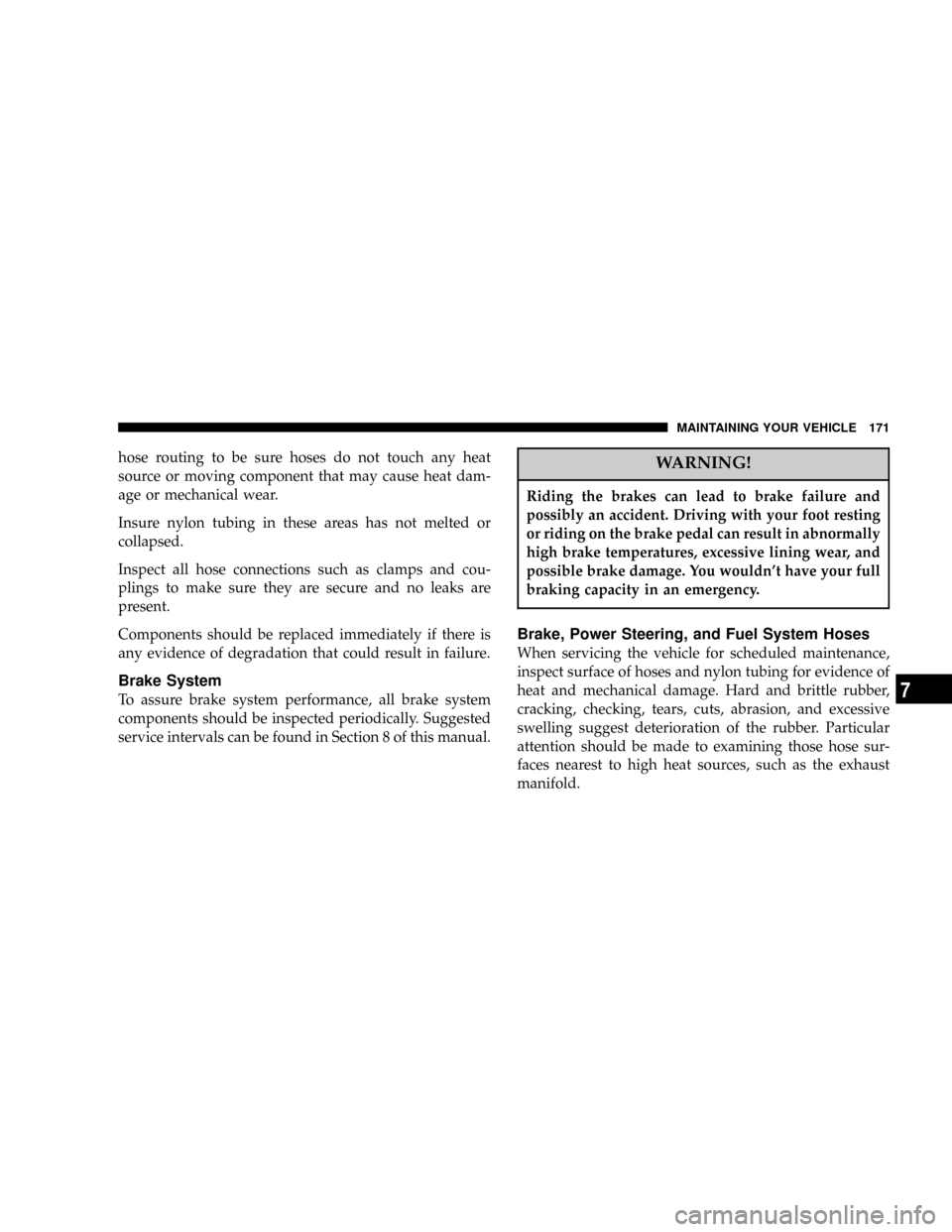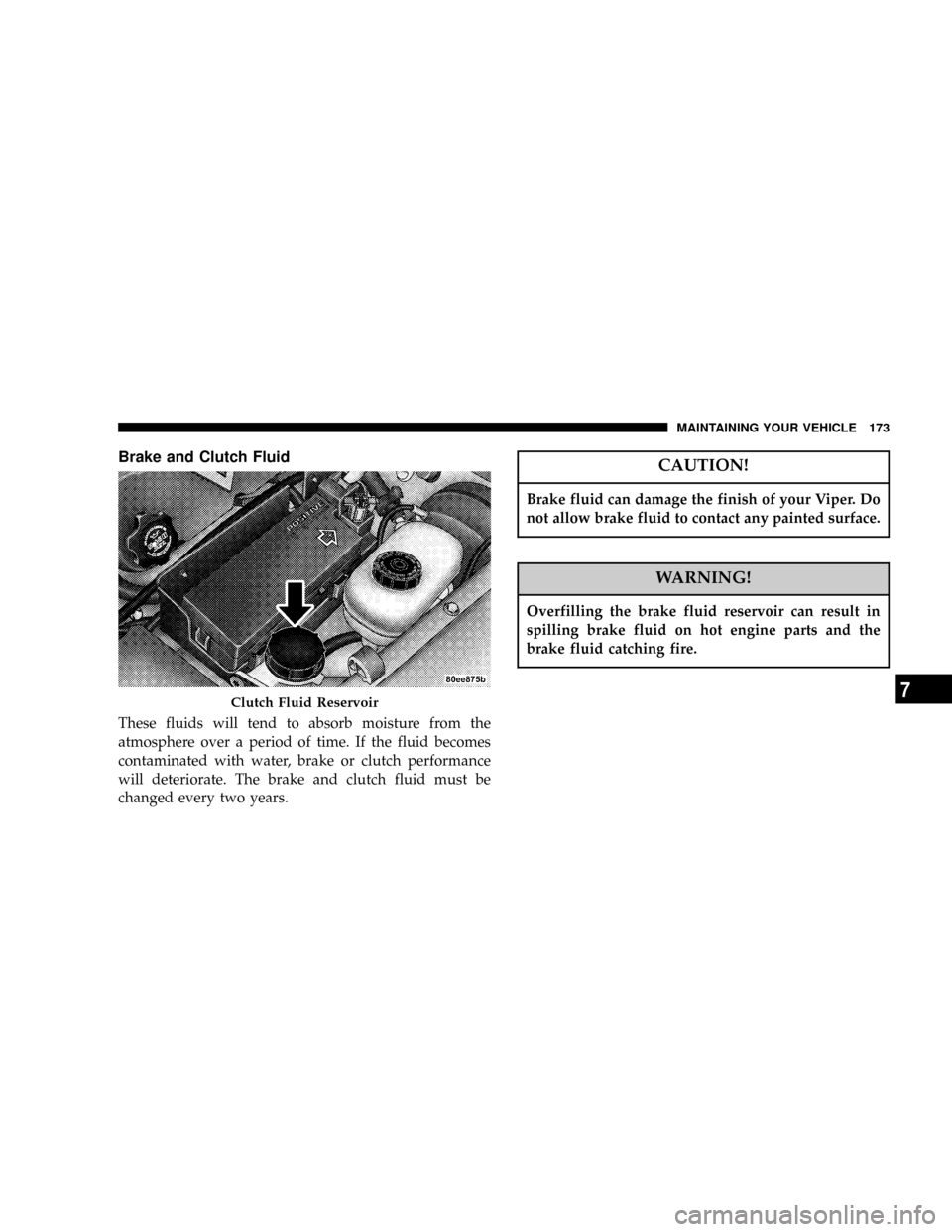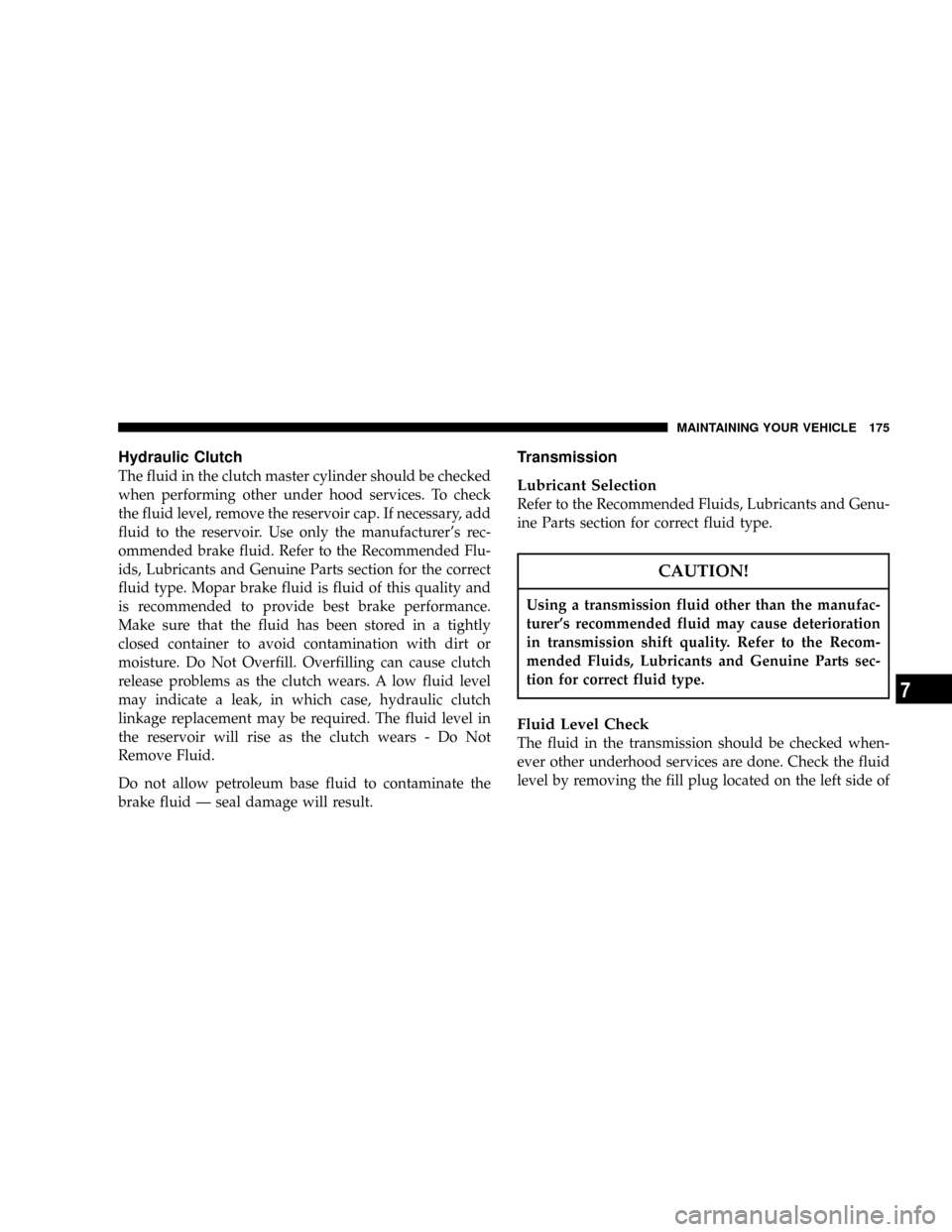DODGE VIPER 2004 ZB / 2.G Owners Manual
Manufacturer: DODGE, Model Year: 2004, Model line: VIPER, Model: DODGE VIPER 2004 ZB / 2.GPages: 236, PDF Size: 4.18 MB
Page 171 of 236

hose routing to be sure hoses do not touch any heat
source or moving component that may cause heat dam-
age or mechanical wear.
Insure nylon tubing in these areas has not melted or
collapsed.
Inspect all hose connections such as clamps and cou-
plings to make sure they are secure and no leaks are
present.
Components should be replaced immediately if there is
any evidence of degradation that could result in failure.
Brake System
To assure brake system performance, all brake system
components should be inspected periodically. Suggested
service intervals can be found in Section 8 of this manual.
WARNING!
Riding the brakes can lead to brake failure and
possibly an accident. Driving with your foot resting
or riding on the brake pedal can result in abnormally
high brake temperatures, excessive lining wear, and
possible brake damage. You wouldn't have your full
braking capacity in an emergency.
Brake, Power Steering, and Fuel System Hoses
When servicing the vehicle for scheduled maintenance,
inspect surface of hoses and nylon tubing for evidence of
heat and mechanical damage. Hard and brittle rubber,
cracking, checking, tears, cuts, abrasion, and excessive
swelling suggest deterioration of the rubber. Particular
attention should be made to examining those hose sur-
faces nearest to high heat sources, such as the exhaust
manifold.
MAINTAINING YOUR VEHICLE 171
7
Page 172 of 236

Inspect all hose clamps and couplings to make sure they
are secure and no leaks are present.
Insure nylon tubing in these areas has not melted or
collapsed.
NOTE:Often, fluids are used during assembly plant
operations to ease the assembly of hoses to couplings.
Therefore, oil wetness at the hose-coupling area is not
necessarily an indication of leakage. Actual dripping of
hot fluid when systems are under pressure (during
vehicle operation) should be noted before hose is re-
placed based on leakage.
High pressure fuel system hoses have unique material
characteristics that provide adequate sealing and resist
attack by deteriorated gasoline.Use only manufacturer specified hoses or their equiva-
lent in material and specification, in any fuel system
servicing. It is mandatory to replace all clamps that have
been loosened or removed during service.
NOTE:Inspection of brake hoses should be done when-
ever the brake system is serviced and at every engine oil
change. If there is any evidence of cracking, scuffing, or
worn spots, the hose should be replaced immediately!
Eventual deterioration of the hose can take place with
possible burst failure.
172 MAINTAINING YOUR VEHICLE
Page 173 of 236

Brake and Clutch Fluid
These fluids will tend to absorb moisture from the
atmosphere over a period of time. If the fluid becomes
contaminated with water, brake or clutch performance
will deteriorate. The brake and clutch fluid must be
changed every two years.
CAUTION!
Brake fluid can damage the finish of your Viper. Do
not allow brake fluid to contact any painted surface.
WARNING!
Overfilling the brake fluid reservoir can result in
spilling brake fluid on hot engine parts and the
brake fluid catching fire.
Clutch Fluid Reservoir
MAINTAINING YOUR VEHICLE 173
7
Page 174 of 236

Master Cylinder
The fluid level in the master cylinder should be checked
when performing underhood services, or immediately if
the brake system warning lamp shows system failure. Be
sure to clean the top of the master cylinder area before
removing the cap. If necessary, add fluid to bring thefluid level up to the requirements described on the brake
fluid reservoir. With disc brakes, fluid level can be
expected to fall as the brake pads wear. However, low
fluid level may be caused by a leak and a checkup may be
needed. Use only the manufacturer's recommended
brake fluid. Refer to the Recommended Fluids, Lubri-
cants and Genuine Parts section for the correct fluid type.
Mopar Brake Fluid is fluid of this quality and is recom-
mended to provide best brake performance. Use of a
brake fluid that may have a lower initial boiling point or
unidentified as to specification, may result in sudden
brake failure during hard prolonged braking.
Use only brake fluid that has been in a tightly closed
container to avoid contamination from foreign matter.
Brake Fluid Reservoir
174 MAINTAINING YOUR VEHICLE
Page 175 of 236

Hydraulic Clutch
The fluid in the clutch master cylinder should be checked
when performing other under hood services. To check
the fluid level, remove the reservoir cap. If necessary, add
fluid to the reservoir. Use only the manufacturer's rec-
ommended brake fluid. Refer to the Recommended Flu-
ids, Lubricants and Genuine Parts section for the correct
fluid type. Mopar brake fluid is fluid of this quality and
is recommended to provide best brake performance.
Make sure that the fluid has been stored in a tightly
closed container to avoid contamination with dirt or
moisture. Do Not Overfill. Overfilling can cause clutch
release problems as the clutch wears. A low fluid level
may indicate a leak, in which case, hydraulic clutch
linkage replacement may be required. The fluid level in
the reservoir will rise as the clutch wears - Do Not
Remove Fluid.
Do not allow petroleum base fluid to contaminate the
brake fluid Ð seal damage will result.
Transmission
Lubricant Selection
Refer to the Recommended Fluids, Lubricants and Genu-
ine Parts section for correct fluid type.
CAUTION!
Using a transmission fluid other than the manufac-
turer's recommended fluid may cause deterioration
in transmission shift quality. Refer to the Recom-
mended Fluids, Lubricants and Genuine Parts sec-
tion for correct fluid type.
Fluid Level Check
The fluid in the transmission should be checked when-
ever other underhood services are done. Check the fluid
level by removing the fill plug located on the left side of
MAINTAINING YOUR VEHICLE 175
7
Page 176 of 236

the transmission. The fluid level should be at the bottom
of the fill hole. Add fluid, if necessary, to maintain the
proper level.
Frequency of Fluid Change
Under normal operating conditions, the fluid installed at
the factory will give satisfactory lubrication for the life of
the vehicle. If the vehicle is operated under severe
conditions, change the fluid as specified in Maintenance
ScheduleB. If contaminated with water, the fluid should
be changed immediately.
Rear Axle
Fluid Level Check
Every 12 months or 6,000 miles (10 000 km) the exterior of
the axle should be checked for evidence of gear oil
leakage. This check should be made with the vehicle in a
level position, supported by the suspension, on an axle
and wheel type hoist, or on the ground. The axle fluidlevel should be between the bottom of the filler plug and
a point approximately 3/8 inch (9.5mm) below the filler
plug.
Lubricant Selection
Use only the manufacturer's recommended transmission
fluid. Refer to the Recommended Fluids, Lubricants and
Genuine Parts section for correct fluid type. This Limited
Slip Differential requires that a friction control additive
be added to the gear oil whenever a fluid change is made.
Frequency of Oil Change
Drain and fill the axle at the interval specified in the
Maintenance Schedules. Change the fluid immediately if
contaminated with water.
176 MAINTAINING YOUR VEHICLE
Page 177 of 236

Wheel Bearings
Your Viper has permanently sealed wheel bearings that
do not require periodic maintenance.
Appearance Care
Your manufacturer's dealer offers a complete line of
products for cleaning your Viper. Follow the instructions
on each container.
Leather or Vinyl Seat/Trim Care and Cleaning
Leather is best preserved by regular cleaning with a
damp soft cloth. Small particles of dirt can act as an
abrasive and damage the leather surface and should be
removed immediately with a damp cloth. Stubborn soils
can be removed easily with a soft cloth and Mopar Total
Clean. Care should be taken to avoid soaking the leather
with any liquid. Please do not use polishes, oils, cleaning
fluids, solvents, detergents, or ammonia based cleaners
to clean the leather. Application of a leather conditioner is
not required to maintain the original condition.
Paint and Trim
Your vehicle is exposed to the corrosive effects of chemi-
cal fall out, salt spray, and road film. To protect not only
the paint and trim, but also exposed mountings and
fixtures, it is important you wash it often and thoroughly.
After washing, allow all surfaces to drain and dry before
parking in a closed garage. Prompt washing may not
thoroughly remove these deposits. Additional cleaners
may be required. When using chemical cleaners formu-
lated for this purpose, be certain they are safe for use on
urethane painted surfaces.
Use soap and water on dull black window trim. Polish or
cleaners may leave a white residue. If desired, you may
polish your vehicle immediately by using Mopar Auto-
mobile Polish.
MAINTAINING YOUR VEHICLE 177
7
Page 178 of 236

Glass Surfaces
All glass surfaces should be cleaned regularly with any
commercial household-type glass cleaner. Never use an
abrasive type cleaner.
Cleaning Plastic Instrument Cluster Lenses
When cleaning the lenses, use care to avoid scratching
the plastic.
NOTE:Never scrape the windows with squeegees,
razor blades, or other sharp instruments.
²Clean with a wet soft rag. A mild soap solution may be
used, but do not use high alcohol content or abrasive
cleaners. If using soap, wipe clean with a clean damp
rag or chamois cloth.
²Dry with a soft tissue.
Damage to the Body Finish
Any stone chips, fractures or deep scratches in the finish
should be promptly repaired.Minor damage can be repaired by using touch-up mate-
rials available at your dealers. More extensive damage
should be corrected in your dealer's paint facility.
Seat Belt Maintenance
Do not bleach, dye or clean the belts with chemical
solvents or abrasive cleaners. This will weaken the fabric.
Sun damage will also weaken the fabric.
If the belts need cleaning, use a mild soap solution or
lukewarm water. Do not remove the belts from the car to
wash them.
Replace the belts if they appear frayed or worn or if the
buckles do not work properly.
Convertible Top Care
Use a mild detergent to clean the top. Avoid heavy
scrubbing and rinse with plenty of clean water. Allow to
dry thoroughly before storage.
178 MAINTAINING YOUR VEHICLE
Page 179 of 236

Carpeting
Vacuum your carpeting regularly to prevent a soil
buildup. Shampoo soiled carpeting with a reliable uphol-
stery cleaner, using a natural sponge or soft bristle brush.
After carpeting dries, vacuum it thoroughly.
Underbody Maintenance
The corrosive materials used for ice and snow removal or
dust control may accumulate on the underbody of your
vehicle. If not removed, these materials may accelerate
rusting and deterioration of underbody components such
as fuel lines, frame, floor pan, exhaust system, etc.
At least twice during the winter months hose down the
wheel wells and underside of the vehicle. Make sure you
remove mud and salt from panels, crevices and ledges,
and that all drain holes and channels are free of debris.
NOTE:You can do more harm by hosing off the vehicle
without removing caked mud and debris.
The frame of your Viper is galvanized for rust-through
protection. It is also dipped in a black E-Coat to protect the
welded areas. Avoid any scratches through to bare metal.
Commercial Car Washes
We do not recommend that you take your Viper through
a commercial car wash.
In the event that you do take your Viper to a commercial
car wash, move the Heater/Air Conditioning blower
control to the lowest setting. This will prevent the possi-
bility of water entering the system.
CAUTION!
The tires on your Viper are wider than the guide
tracks on most washes and the low ground clearance
of your vehicle may not be compatible with some car
wash equipment. You could damage your vehicle.
MAINTAINING YOUR VEHICLE 179
7
Page 180 of 236

FUSES Ð Power Distribution Center
CAUTION!
When replacing a blown fuse, it is important to use
only a fuse having the correct amperage rating. The
use of a fuse with a rating other than indicated may
result in a dangerous electrical system overload. If a
properly rated fuse continues to blow, it shows a
problem in the circuit that must be corrected.
180 MAINTAINING YOUR VEHICLE